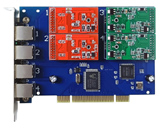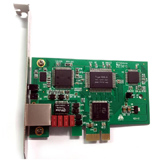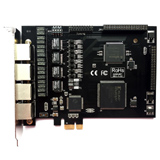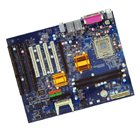
| Index |
||||||||||||||||
About VoIP Mass-market telephonyA major development starting in 2004 has been the introduction of mass-market VoIP services over broadband Internet access services, in which subscribers make and receive calls as they would over the PSTN. Full phone service VoIP phone companies provide inbound and outbound calling with Direct Inbound Dialing. Many offer unlimited calling to the U.S., and some to Canada or selected countries in Europe or Asia as well, for a flat monthly fee. These services take a wide variety of forms which can be more or less similar to traditional POTS. At one extreme, an analog telephone adapter (ATA) may be connected to the broadband Internet connection and an existing telephone jack in order to provide service nearly indistinguishable from POTS on all the other jacks in the residence. This type of service, which is fixed to one location, is generally offered by broadband Internet providers such as cable companies and telephone companies as a cheaper flat-rate traditional phone service. Often the phrase "VoIP" is not used in selling these services, but instead the industry has marketed the phrases "Internet Phone", "Digital Phone" or "Softphone" which is aimed at typical phone users who are not necessarily tech-savvy. Typically, the provider touts the advantage of being able to keep one's existing phone number. At the other extreme are services like Gizmo Project and Skype which rely on a software client on the computer in order to place a call over the network, where one user ID can be used on many different computers or in different locations on a laptop. In the middle lie services which also provide a telephone adapter for connecting to the broadband connection similar to the services offered by broadband providers (and in some cases also allow direct connections of SIP phones) but which are aimed at a more tech-savvy user and allow portability from location to location. One advantage of these two types of services is the ability to make and receive calls as one would at home, anywhere in the world, at no extra cost. No additional charges are incurred, as call diversion via the PSTN would, and the called party does not have to pay for the call. For example, if a subscriber with a home phone number in the U.S. or Canada calls someone else within his local calling area, it will be treated as a local call regardless of where that person is in the world. Often the user may elect to use someone else's area code as his own to minimize phone costs to a frequently called long-distance number. For some users, the broadband phone complements, rather than replaces, a PSTN line, due to a number of inconveniences compared to traditional services. VoIP requires a broadband Internet connection and, if a telephone adapter is used, a power adapter is usually needed. In the case of a power failure, VoIP services will generally not function. Additionally, a call to the U.S. emergency services number 9-1-1 may not automatically be routed to the nearest local emergency dispatch center, and would be of no use for subscribers outside the U.S. This is potentially true for users who select a number with an area code outside their area. Some VoIP providers offer users the ability to register their address so that 9-1-1 services work as expected. Another challenge for these services is the proper handling of outgoing calls from fax machines, TiVo/ReplayTV boxes, satellite television receivers, alarm systems, conventional modems or FAXmodems, and other similar devices that depend on access to a voice-grade telephone line for some or all of their functionality. At present, these types of calls sometimes go through without any problems, but in other cases they will not go through at all. And in some cases, this equipment can be made to work over a VoIP connection if the sending speed can be changed to a lower bits per second rate. If VoIP and cellular substitution becomes very popular, some ancillary equipment makers may be forced to redesign equipment, because it would no longer be possible to assume a conventional voice-grade telephone line would be available in almost all homes in North America and Western-Europe. The TestYourVoIP website offers a free service to test the quality of or diagnose an Internet connection by placing simulated VoIP calls from any Java-enabled Web browser, or from any phone or VoIP device capable of calling the PSTN network.
|
||||||||||||||||





